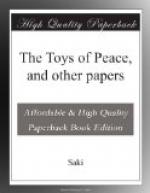“Why in the name of all that is unnecessary and perverse should Kathleen choose this man for her future husband?” was the question that Rupert asked himself ruefully. There was young Malcolm Athling, as nice-looking, decent, level-headed a fellow as any one could wish to meet, obviously her very devoted admirer, and yet she must throw herself away on this pale-eyed, weak-mouthed embodiment of self-approving ineptitude. If it had been merely Kathleen’s own affair Rupert would have shrugged his shoulders and philosophically hoped that she might make the best of an undeniably bad bargain. But Rupert had no heir; his own boy lay underground somewhere on the Indian frontier, in goodly company. And the property would pass in due curse to Kathleen and Kathleen’s husband. The Sheep would live there in the beloved old home, rearing up other little Sheep, fatuous and rabbit-faced and self-satisfied like himself, to dwell in the land and possess it. It was not a soothing prospect.
Towards dusk on the afternoon following the bridge experience Rupert and the Sheep made their way homeward after a day’s mixed shooting. The Sheep’s cartridge bag was nearly empty, but his game bag showed no signs of over-crowding. The birds he had shot at had seemed for the most part as impervious to death or damage as the hero of a melodrama. And for each failure to drop his bird he had some explanation or apology ready on his lips. Now he was striding along in front of his host, chattering happily over his shoulder, but obviously on the look-out for some belated rabbit or woodpigeon that might haply be secured as an eleventh-hour addition to his bag. As they passed the edge of a small copse a large bird rose from the ground and flew slowly towards the trees, offering an easy shot to the oncoming sportsmen. The Sheep banged forth with both barrels, and gave an exultant cry.
“Horray! I’ve shot a thundering big hawk!”
“To be exact, you’ve shot a honey-buzzard. That is the hen bird of one of the few pairs of honey-buzzards breeding in the United Kingdom. We’ve kept them under the strictest preservation for the last four years; every game-keeper and village gun loafer for twenty miles round has been warned and bribed and threatened to respect their sanctity, and egg-snatching agents have been carefully guarded against during the breeding season. Hundreds of lovers of rare birds have delighted in seeing their snap-shotted portraits in Country Life, and now you’ve reduced the hen bird to a lump of broken feathers.”




